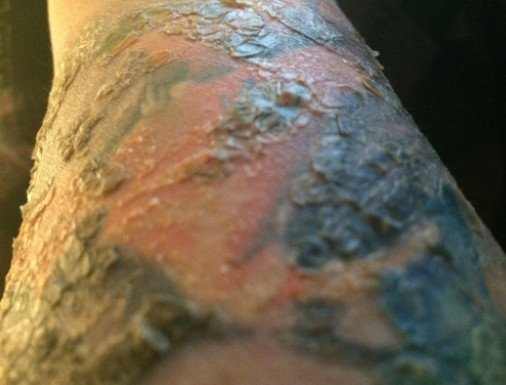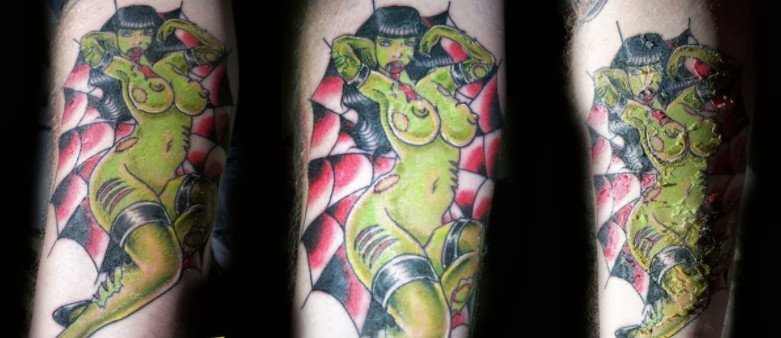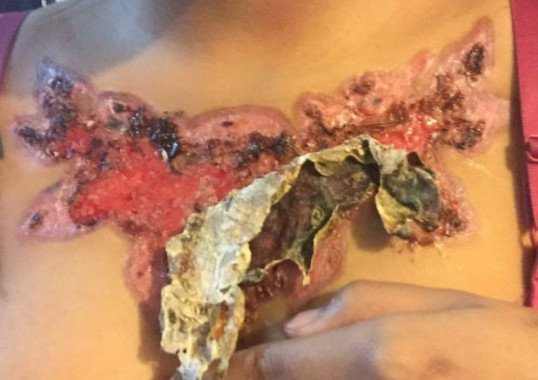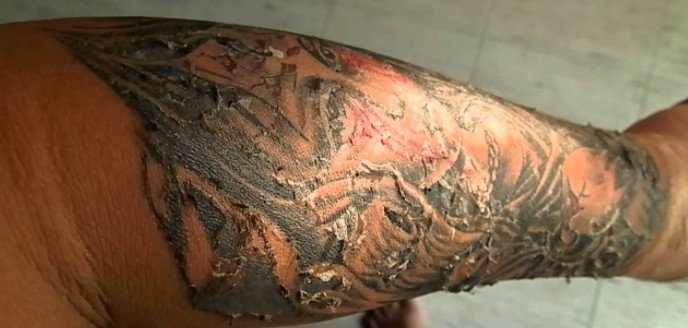Tattoo peeling from your skin can be an alarming sight. This should not worry you, though, since it is a normal thing during the tattoo healing process. Every single skin tattoo that is inked into an area of skin might cause an open wound that your body will need to protect until it heals.
Here is an insight into what might cause your tattoo to peel, what to do to stop the peeling, and what you need to do before and after getting a tattoo.
When does a tattoo start to peel?
New tattoos will generally peel towards the end of the first week of healing, normally between 5 to 7 days. Again, this will be slightly different for everyone, but you should be seeing at least the start of the peeling phase beginning by the end of the week.

It should not worry you that your tattoo hasn’t started peeling by this point. As mentioned, all tattoos heal and peel differently, so yours may just be taking slightly longer. On smaller tattoos, the peeling can be extremely light, and the area may have already begun peeling without you even noticing. This could be because you might be keeping the area well moisturized. This is because if your skin is often dry or flaky, the characteristics of peeling skin look much less noticeable.
What to do when a tattoo is peeling
During the tattoo healing process, your tattoo aftercare routine is very important to ensure your tattoo peels and heals as well as possible.
The following are some dos and don’ts when your tattoo is peeling;
Don’ts
Don’t pick or pull your peeling tattoo.
This is the worst thing you could do to your peeling tattoo. Even if the peeling tattoo may look like it’s ready to come off, it might still be attached to your skin. If you pick or pull the skin before it’s completely ready, you take the risk of pulling unsettled ink out along with the peeling skin, leading to patches within your tattoo.
Do not re-bandage once you have removed a bandage completely.
Do not shave or wax the area until the tattoo is completely healed.
Do’s
Keep your tattoo well moisturized.
Moisturizing your new tattoo will not only help soothe any itching caused by the tattoo but also potentially help your tattoo heal faster thanks to the many useful vitamins and minerals that the majority of moisturizing lotions and ointments contain.
Moisturizing will also change the dried, flaky pieces of skin to more appealing and healthy skin. It also stops the scabs from the peeling tattoos from drying out and cracking too much. Some extra moisture will also help stick the flaky pieces of skin flush against the body and hence prevents it from getting accidentally ripped off.
How long does it take for a tattoo to peel?
All tattoos peel for varying lengths of time, depending on individual circumstances. Most tattoos, however, will peel for roughly a week or so. Tattoos on more overused areas of the skin (like the wrists and elbows) will take a little longer to completely peel, but tattoos on more soft and supple areas may peel completely in just a few days.
Sometimes tattoos may peel twice. If this happens, there is one relatively heavy peeling phase, followed by some very light peeling that may look like barely-noticeable specs of skin coming away from the area.
Peeling tattoo care
There are some things you should do to ensure the longevity of your tattoo. If your tattoo is peeling, here is what you need to know about caring for it;
1. Keep it clean
Gently wash your tattoo with a mild, antibacterial soap. Never use a washcloth, sponge, or bath puff material while washing the area. You should then thoroughly rinse all of the soap off. It’s important to carefully remove this debris to prevent the peeling tattoo from more scabbing.
2. Don’t rub
Rubbing your tattoo can pull off the thin layer that is also referred to as a scab, which forms a protective layer over your tattoo. This scab is necessary, and you don’t want to pull it off before its ready, or you may end up with larger scabs that are harmful. You should, therefore, apply ointment, lotion, or moisturizer.
3. Avoid soaking your tattoo
Sports or any other physical activity that leads to sweating may irritate your tattoo. You can also avoid sports where the scab from peeling can be knocked off. You should also avoid soaking in any kind of water, including bathtubs, oceans, lakes, swimming pools, or hot tubs. Not only can the water seep under the peeling tattoo and draw it out, but also the germs found in water sources can potentially cause an infection, which can cause scabbing and scarring.
- Keep your showers to 10 minutes or less
- Wear clothes designed to wick away moisture
- Change clothes immediately after working up a sweat. If this is not possible, you should periodically wipe the sweat off your tattoo.
4. Apply lotion or ointment
Wipe a thin layer of ointment over your peeling tattoo using clean fingers or a clean paper towel. Blot away excess oil with a clean paper towel.
We recommend Intensive Care Body Lotion from Vaseline (Check price on Amazon)
- You should only apply enough lotion or ointment to just cover the tattoo. The skin should not look greasy or soggy.
- Massage the ointment or lotion into your skin until it disappears. Don’t leave a coating over the tattoo.
- Ointments generally last longer and are better at preventing the peeling tattoo from drying out, but a lotion will surface if you do not have an ointment to use.
- Do not use products containing aloe vera, alcohol, or cortisone.
5. Don’t pick the scabs
Tattoo peeling can involve some forms of scabbing that may emerge after several days or weeks. It is, however, normal to experience scabbing, but very heavy scabs should be closely examined. You should note that picking the scabs may scar your tattoo, and this could interfere with the perfect appearance. This could lead to eventual peeling off the scabs.
6. Do not re-bandage the tattoo
even if your skin feels raw or sensitive, you should not apply a new bandage or wrapping to your skin. You should, however, be exposed to the air to heal properly.
7. Keep away from sun rays

Sun will always remain an enemy to your tattoo. It is, therefore, important that you stay away from strong ultraviolet rays since they can accelerate the peeling of your tattoo. You can also apply sunscreen to the area every time you plan to go outside.
- The sunscreen you use should offer broad-spectrum protection against UVB and UVA rays. It also has a water-resistant formula.
- Apply the sunscreen 20 minutes before you go outside, if possible. This provides enough time for it to work its way into the skin.
Tattoo peeling before and after
A tattoo will appear different before and after peeling. Some might get infected and even start to swell or peel.

How to remove a peeling tattoo
Nearly 30% of people living in the US have got at least one tattoo. According to research, 25% of that population regret having it and therefore choose to have it removed. A dermatologist usually performs tattoo removal, but you could still do it at home. If you are thinking of having a tattoo removed, you should be prepared for the potential discomfort and the limitations.

Limitations include;
- Cost- removing a tattoo is a very expensive procedure if you choose to have it done by professionals and in a safe way. For instance, in the UK, private clinics charge about $150 a session to remove a small tattoo and up to $800 for a larger one.
- It can be a frustratingly slow process- you may need several sessions to completely removes a tattoo.
- You may have some fragments left on your skin since not all tattoos can be entirely removed.
- Tattoo removal is not recommended if you have dark skin, a suntan, or a fake tan. It is also not recommended in the early stages of pregnancy.
The following are some of the procedures you can consider to remove a peeling tattoo;
1. Trichloracetic Acid (TCA) Tattoo removal
TCA is one of those inexpensive old school remedies that just works and works well. It is also used to soften fine stretch marks, remove moles, warts, skin tags, corns, freckles, brown spots, and even remove homemade tattoos. This solution works by generating an inflammation on the surface of the skin above the tattoo, which, after around a week, peels and sheds. The TCA causes the ink in the peeling tattoo to break down and move towards the surface of the skin as new skin replaces that which has been shed. This product has to be applied at intervals of 6 weeks until the tattoo is completely cleared. The cost of TCA tattoo removal is cheap and highly depends on the length of your treatment.
2. Tattoo removal cream
Tattoo removal cream is one of the most popular methods you could use to remove to a peeling tattoo at home. These creams are generally chemical exfoliates which work by removing top layers of skin and breaking down the inks from the peeling tattoo. They contain a certain type of acid that could cause a certain degree of discomfort but not compared to pain and scarring that could be associated with laser treatments. The use of a soothing balm along with the cream, is highly recommended. This form of removal is not as effective as professional procedures, and effects could take several months to become apparent. Success is not guaranteed, but it is worth trying if undergoing surgery is quite difficult.
Significant reports from research suggest that creams mostly fade the tattoos, and only a few report total removal of the tattoo. You should, therefore, be aware before you choose this procedure that it could take 9 to 12 months.
3. Laser tattoo removal
A peeling tattoo can be removed gradually over a series of sessions using a laser. Laser tattoo removal techniques can eliminate your tattoo with minimal side effects. The energy from the laser breaks down the tattoo ink into tiny fragments, which are eventually absorbed into the bloodstream and safely passed out of the body.
Black tattoo pigment absorbs all laser wavelengths, making it the easiest to treat. Other colors can only be treated by selected lasers based upon the pigment color. You should make sure that you find a reputable dermatologist or a cosmetic surgeon to ensure proper treatment and care. Treatments with laser vary from patient to patient depending on the age, size, and type of tattoo. The color of the patient’s skin, as well as the depth to which the tattoo pigment extends, will influence the removal technique.
What to expect during a laser tattoo removal session;
- You’ll be given a pair of protective eye shields
- Your doctor will test your skin’s reaction to the laser to determine the most effective energy for treatment
Immediately following the treatment;
- the skin is red with raised bumps. Holding an ice pack to soothe the treated area, and then apply an antibiotic cream or ointment and bandage to protect it.
- The skin becomes more sensitive to the sun. Make sure to apply a sunscreen before going out
- in the cause of treatment, and the skin may bleed slightly before scabbing over. You can help this by applying aloe vera gel or Vaseline on any blisters or scabbing.
Side effects
Laser treatment is often safer than many other tattoo removal methods.
4. Excision tattoo removal
Tattoo excision is a common treatment, especially after failed laser treatment. It is the procedure of removing a tattoo by actually cutting it out. This method positively removes the unwanted tattoo and must be done by a skilled surgeon.
The surgeon will usually do an excision when the tattoo is small, but if it is a bigger tattoo, then the doctor will most likely have to do the removal in two or more sessions. The surgeon would remove the inside of the tattoo first, and then when you go back, they would perform an excision on the outside of the tattoo. You don’t have to worry even if you are afraid of surgeries. This procedure is pretty simple.
Procedure;
- The excision tattoo removal will begin with the doctor giving you an injection of a local anesthetic to numb the area with the tattoo.
- When the skin is completely numbed, the doctor will begin the excision process- the doctor removes the first or second layer of skin.
- Your doctor will then stitch it up using sutures.
- Sometimes, when removing a larger tattoo, the doctor might have to graft skin from another part of your body in this place so that they can close it up again- the graft resembles your skin when it heals, and the procedure doesn’t hurt either.
- After 48 hours, you can take a shower with improvement in symptoms that continue to improve as time passes. The wound needs to be kept clean to prevent infection and avoid direct exposure to sunlight to avoid scar color changes for several weeks after the excision.
Safety of the excision procedure;
Surgical excision of the tattoo is a safe procedure. However, some factors may affect the outcome; these factors depend on the patient, the environment under which the procedure has been carried out, and the skill of the surgeon. Your general health, well-being, and your tissues’ power of repair and healing play an important part in recovery.
The environment and conditions under which the operation has been carried out are important because of the risk of infection. The skills of the surgeon play a crucial role in the overall outcome of your tattoo surgical removal because apart from the operation, the surgeon can influence the selection and preparation of the patient for operation, and making sure the operation is carried out under sterile, aseptic and optimal conditions.
5. Dermabrasion tattoo removal
This procedure is less commonly followed nowadays. This process involves scraping away the top layers of the skin to remove the pigments in the tattoo. This can be very painful and could cause scarring, although it can be effective for removing all kinds of tattoos.
Procedure;
- A week before this procedure is administered, you should avoid smoking or certain medications such as aspirin, which could cause bleeding after the treatment.
- A local anesthetic to help numb the area. The tattoo is then cleaned with antiseptic and a freezing solution, liquid nitrogen is often used to harden the skin. This makes it easier to work on the tattoo.
- A special sanding device called a dermatome is then used. It is applied to the tattoo, it can cause a fair amount of bleeding, but it scrapes away layers of skin which will remove the tattoo. Most tattoos are deeply seated underneath the skin, which can result in permanent scarring; this results in a new layer of skin.
- The treated area of the skin will be red, swollen, and sore and normally takes a few weeks to heal. A bandage will be applied to deal with any bleeding following this procedure.
It usually takes a couple of weeks for the treated area to heal, but the reddened appearance may take up to three months.
Risks and side effects of dermabrasion
- You will expect to experience some bruising and swelling following the treatment, as well as some bleeding and weeping from the wounds
- The procedure is painful, and the area is often left feeling numb or with a tingling sensation- various gels and creams can be applied to soothe the area, and exposure to the sun following the procedure must be avoided.
- Permanent scarring is common- this is due to the removal of top layers of the skin, especially in people with darker complexions. It can take up to 6 months for the wound to heal completely- during this period, you may experience burning, itching, and general pain around the wound.
- You should conduct proper aftercare to avoid cases of infection as the area is highly vulnerable because of the lack of protective layers.
- If you have a history of suffering bleeding disorders or keloid scars, you can’t use dermabrasion for tattoo removal- this is because of the pain and scarring involved in this procedure, it is, therefore, worth exploring alternative methods before opting for this method.
References
- Tattoo removal: http://www.nhs.uk/Conditions/cosmetic-treatments-guide/Pages/tattoo-removal.aspx
- Why your tattoo looks like it’s about to flake off: https://authoritytattoo.com/tattoo-peeling/
- Reasons for tattoo peeling and fading: http://www.skin-artists.com/tattoo-fading.htm
- When do tattoos start to peel: http://www.healcure.org/tattoo/tattoo-peeling-peeling-process-ink-peeling-tattoo-care/
- Laser tattoo removal: http://www.webmd.com/skin-problems-and-treatments/laser-tattoo-removal#1


